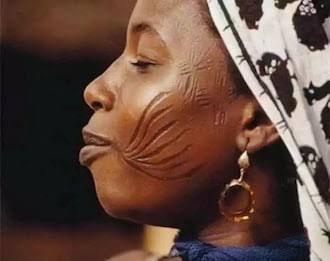By Mamuda Sanusi,
Facial marks are tears made on parts of the body, especially the face. It occurs in different shapes and sizes. It is also referred to as tribal marks. The practice is common in many parts of Nigeria irrespective of tribe, culture and religion.
Since tribal marks are used majorly to differentiate one ethnic group from the other, as they are varied. There are marks on the cheeks, forehead, the arms, under the chin and so on.
These marks can be in vertical lines, horizontal or both. They could also come in slanted lines on both cheeks. These marks are in patterns based on the ethnic group of their bearer and have different meanings and different names.
Tribal marks practise in Nigeria dates back to the colonial era when the colonial masters were capturing people and taking them to foreign countries for slavery. People started giving family members marks to identify and recognise them if they were captured and later found.
In the Hausa-Fulani tribes, these incisions were a form of identity as the different parts of the land and various families had distinct ways of making the lacerations on the face. The mark is as old as the Northern part of Nigeria.
The facial marks are varied among the Hausa, and these include Gobirci with temple marks to differentiate Hausas from Gobir, an old kingdom which now comprises Sokoto and Zamfara States. Multiple lines lead to the corners of the mouth and more markings on the temple.
Gobirci with single Tage which has marks on both cheeks. This is common among the younger generation. The Lekanci marks are common among members of the Lekayewa clan of Argungu, Kebbi State. It is made up of ten marks on the right cheek and nine on the left. The Susa’na has four vertical lines on both faces; this tribal mark is common to the Kanuri tribe in Borno State.
Mami, which has seven sets of vertical lines on both cheeks and one on the forehead. Rijiya, this Hausa tribal mark features varying numbers of horizontal marks across both cheeks, depending on family, customs or specific northern regions. Arauci is two marks drawn on both cheeks, from the ears to the corners of the mouth.
However, the nature of the tribal mark on someone, can reveal where one comes from. The mark shows the ethnic group such a Northerner belongs. These tribal marks come in different shapes and sizes based on the locality of the bearer. Tribal marks became very popular during the colonial era where people were being sold into slavery.
These marks were given to enable recognition of family members who were taken away, in the event they gained freedom or found their way back home, many years after.
It is a symbol of beauty unknown to many people. This is due to the widespread disapproval that comes with it. Tribal marks are often considered among the Hausa as a dent to beauty as they make people look different.
However, in some Hausa cultures, specific tribal marks are engraved on the skin as a symbol of beauty. These marks are done on specific parts of the body, in specific shapes and sizes, to represent objects of beauty.
They are also largely used to show the different social strata in a given society. In rural communities, members of a royal clan may be given a certain mark which informs people of their royal heritage wherever they go.
The King in the North and his family who hold the highest degree of royalty in a community may have special tribal marks that are exclusive to them. Such marks differentiate them from the rest and give them immunity against certain things.
Tribal marks play a vital role in saving lives. In the event of certain illnesses that are considered to be strange, some people go the traditional route of treatment. These marks are engraved on the body of the sick one and certain locally prepared concoctions are applied on them. This practice existed among the Hausa tribe in the North but is gradually going into oblivion.
Today, tribal mark is seen as an abuse of children rights among the Hausa in Northern Nigeria. This is based on section 24 of the Child’s Rights Act which stipulates that, No person shall tattoo or make a skin mark or cause any tattoo or them.
There were several bills passed by the National Assembly to outlaw the tribal marks, the aged long culture. The law prescribed imprisonment and fine for offenders. The issue of western civilization, globalisation and religion among others are impediments against the ancient (tribal marks) culture in the Northern part of the country.
There is therefore, the need to reawaken the cultural heritage because of the significant roles it plays among Hausa communities. It will enable the present generation to rediscover themselves. The stakeholders in the cultural industry in the North should formulate a roadmap for the rejuvenation of facial marks.
Written by: Mamuda Sanusi, Assistant Chief, Antiquities Protection Officer, National Museum, Ile-Ife.

